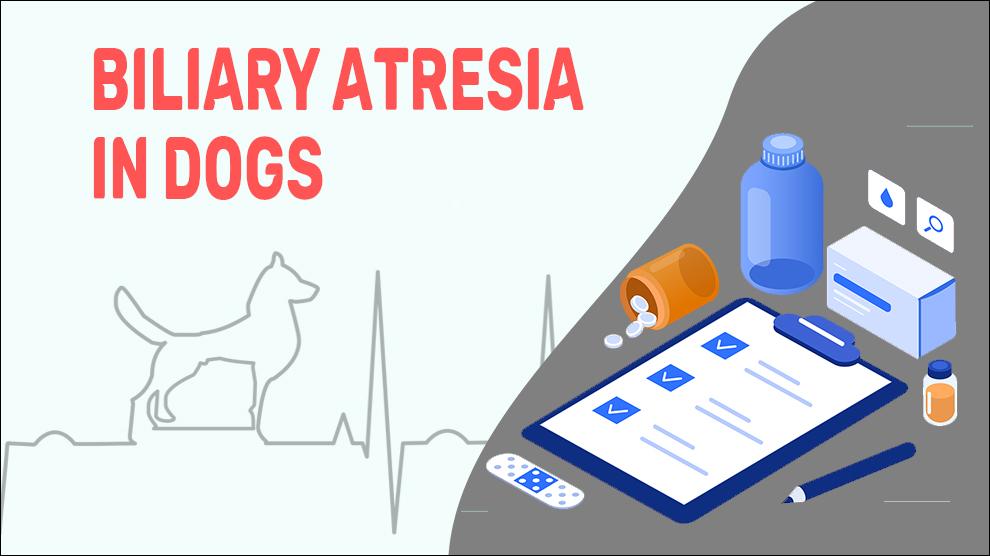What is Biliary Atresia In Dogs?
Biliary atresia is a congenital or maldevelopment of intrahepatic biliary structures (such as bile ducts outside or inside the liver) that are scarred, blocked, or even absent.
Biliary atresia is a relatively rare condition of indefinite or hereditary origin and an as-yet unexplained pathologic mechanism. This build of bile in the liver damages the liver and other vital body functions
Usually, the first sign of biliary atresia is yellow-tinted skin and eyes (jaundice) which results from the buildup of bile in the body. Most dogs with biliary atresia have abnormalities in other organs, such as heart defects or issues with their spleen.
The cause of bile duct obstruction is indefinite or highly variable, and so is the prognosis.
Symptoms Of Biliary Atresia In Dogs
- Jaundice (yellow tinge of skin and sclera of eyes),
- White or clay-colored or beige stools (due to bile or bilirubin)
- Dark yellow or brown urine
- Weightloss/irritability
- A swollen belly (enlarged liver and spleen)
- Ascites (fluid in the belly)
- Liver failure (if the biliary atresia is not treated)
Treatment Options For Biliary Atresia In Dogs
There is no cure for biliary atresia. The treatment depends on the underlying disease or condition or any exposure to toxins.
Recently, veterinarians started to try endoscopic retrograde cholangiography (ERC) as a diagnostic and therapeutic tool for minimally invasive endoscopic treatment of extrahepatic biliary obstruction (This has been already used for humans)
Surgery will be the option when there is no other way and the surgeon removes the spoiled bile ducts and replaces them with a piece of the small intestine.
Home Remedies For Biliary Atresia In Dogs
Follow the instructions given to you by your veterinarian for the entire recommended time period. No matter how badly you want relief for your dogs or what you hear from other dog owners, talk with your vet before trying any home remedy
Make sure to provide plenty of drinking water.
If any specific diet has been suggested to your dog, follow the diet very strictly, and never provide or allow others to give your dog treats or other food
Follow all of the veterinarian’s instructions and adhere to your dog's drug schedule properly (don’t miss a dose or overdose)
How to Prevent Biliary Atresia In Dogs?
Prevention of biliary atresia is not possible because of the reason that either it occurs out of blue or from birth itself.
It is essential to adhere to the veterinarian’s care instructions, as recovery will depend on your dog’s cause of the disease and course of treatment.
Affected Dog Breeds Of Biliary Atresia
There is no breed disposition. This condition is slightly more often in females than in males
Additional Facts For Biliary Atresia In Dogs
Biliary Atresia in dogs is a Progressive, obliterative, fibrosclerosing cholangiopathy that results in obstruction of both intrahepatic and extrahepatic bile ducts.
Bile is a digestive fluid that is produced in the liver and stored in the gallbladder. Then, it travels through bile ducts to small bowels, where it helps the body break down, digest, and utilize appropriately. When a dog has biliary atresia, the bile ducts are blocked and bile is backed up in the liver. Consequently, bile can’t flow to the small intestine, and the buildup of bile in the liver causes cirrhosis. If not treated, it can be deadly.
It is still unclear what triggers biliary atresia, but may include:
- Autoimmune mediated bile duct destruction
- Viral infections
- Exposure to toxins, harmful chemicals
- Gene mutation (Biliary atresia is not hereditary)
- Primary perinatal hepatobiliary virus infection and a secondary autoimmune-mediated or inflammatory bile duct injury
When To See A Vet For Biliary Atresia In Dogs?
Appropriate diagnosis of this disease is always best left to your vet to make sure that it is not progressing into a serious form.
As in many cases, the biliary atresia etiology is often serious in nature and it can be treated early and efficiently.
Dog Food Suggestions For Biliary Atresia
What foods should I avoid?
- Fatty meats - beef, whole or ground, steak or high-fat cuts of red meat
- Avoid full-fat cheese, sauces or gravies made with cream, full-fat yogurt
- Avoid white or other processed bread, cookies, cakes
There are still plenty of things you can provide your dogs
High-fiber foods
- Whole grain bread, rice, and cereal
- Green beans, peas
- Psyllium husk
- Beet pulp
- flaxseed
Lean meats or meat alternatives
- Chicken breast
- Ground meat (beef, pork, chicken, turkey)
- Salmon, trout, herring
- Whitefish like cod and halibut
Nutrient-dense, vitamin-dense fruits and veggies
- Legumes, such as lentils, peas, or beans
- Cauliflower, cabbage, broccoli
- Spinach, kale
- Tomatoes
- Citrus, such as oranges and limes
- Avocadoes, blueberries, blackberries, raspberries
Conclusion
As biliary atresia is a disorder of unknown origin, treatment will depend on the predisposing cause or any exposure to harmful toxins
Regular follow-up appointments with your veterinarian are essential as recovery would be slow. Always follow the progress and adjustment of the drugs or treatment techniques as necessary.

















